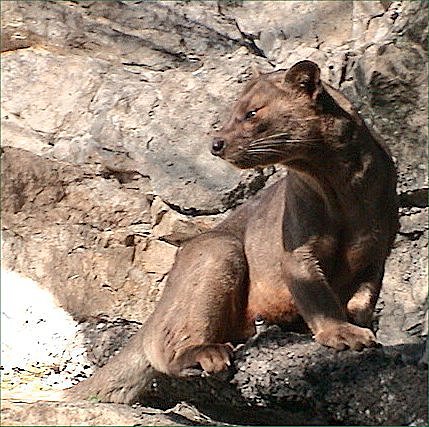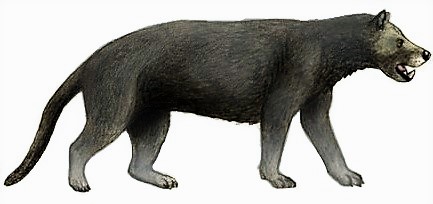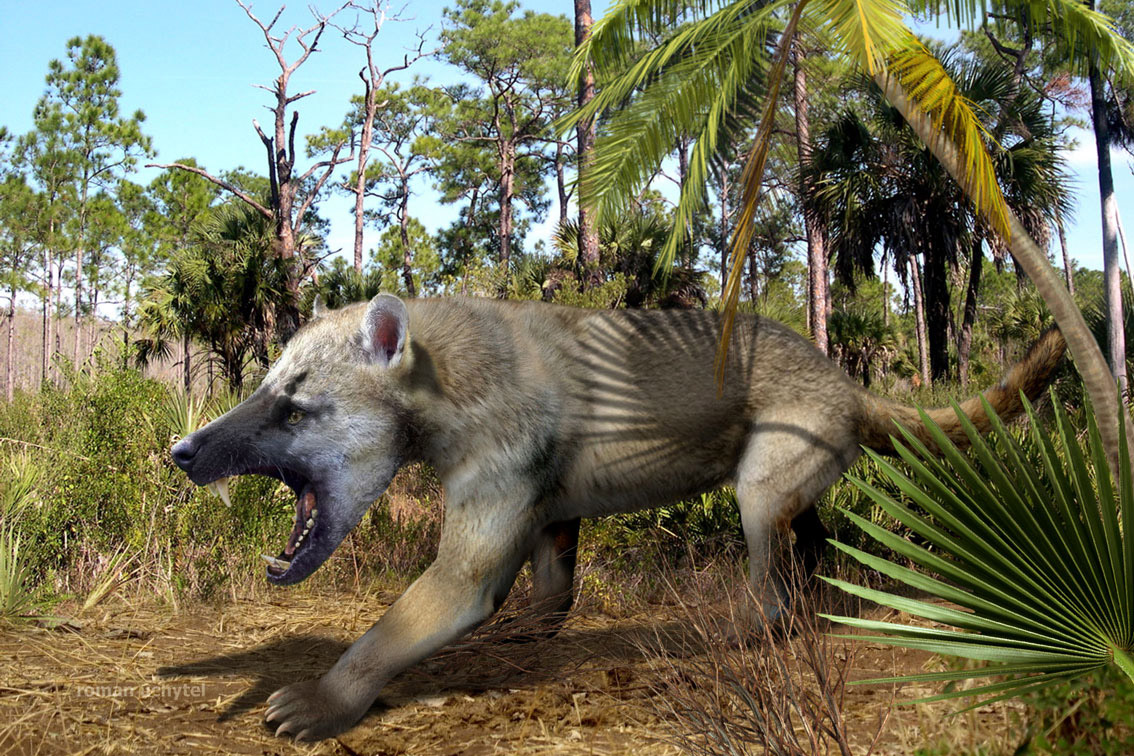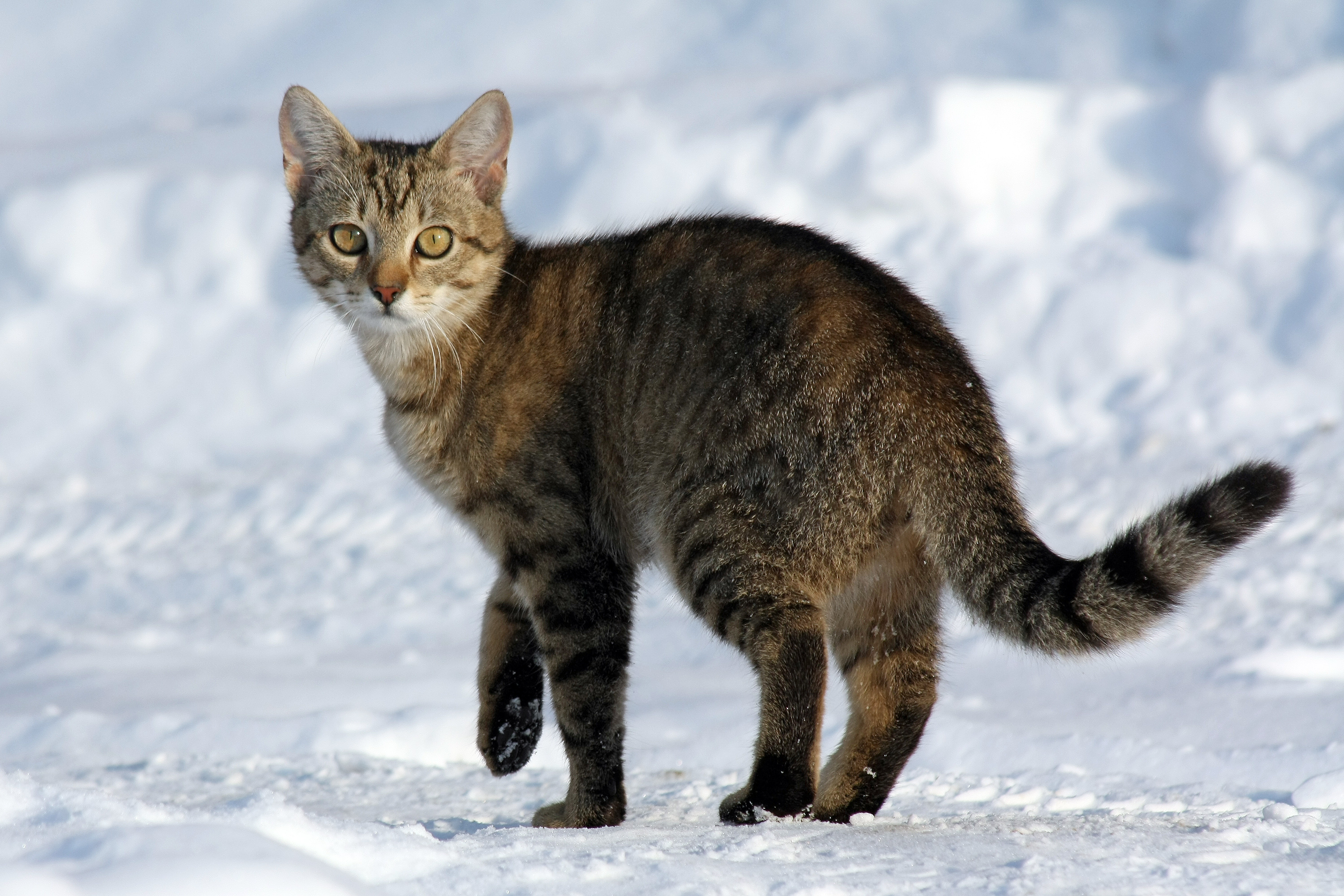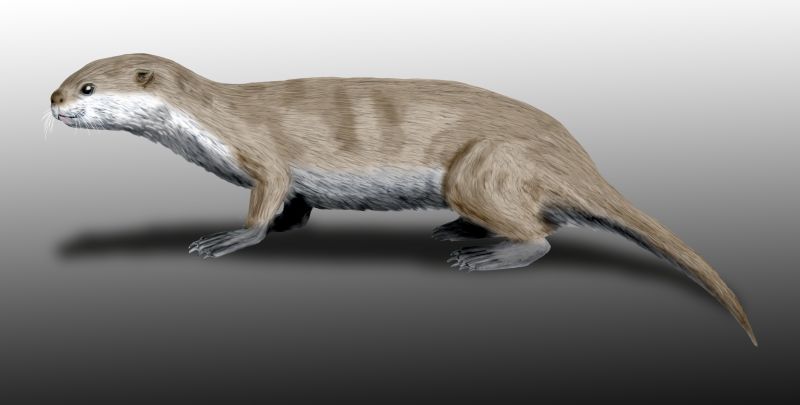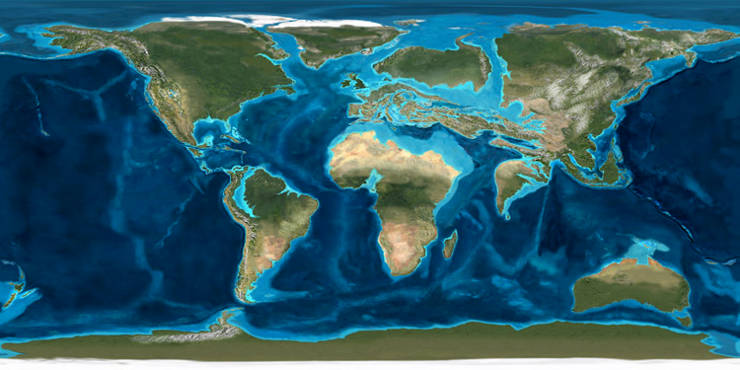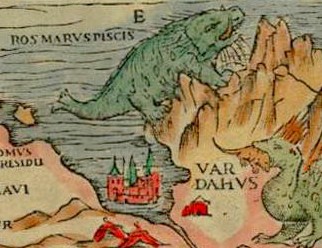|
Caniforms
Caniformia is a suborder within the order Carnivora consisting of "dog-like" carnivorans. They include dogs (wolves, foxes, etc.), bears, raccoons, and mustelids. The Pinnipedia ( seals, walruses and sea lions) are also assigned to this group. The center of diversification for the Caniformia is North America and northern Eurasia. Caniformia stands in contrast to the other suborder of Carnivora, the Feliformia ("cat-like" carnivorans), the center of diversification of which was in Africa and southern Asia. Description Most members of this group have nonretractile claws (the fisher, marten, sea otter ( forepaws only), red panda, and ringtail, and some foxes have retractile or semi-retractile claws) and tend to be plantigrade (with the exception of the Canidae). Other traits that separate the Caniformia from the Feliformia is that caniforms have longer jaws and more teeth, with less specialized carnassial teeth. They also tend more towards omnivory and opportunistic ... [...More Info...] [...Related Items...] OR: [Wikipedia] [Google] [Baidu] |
Feliformia
Feliformia is a suborder within the order Carnivora consisting of "cat-like" carnivorans, including Felidae, cats (large and small), hyenas, mongooses, viverrids, and related taxa. Feliformia stands in contrast to the other suborder of Carnivora, Caniformia consisting of "dog-like" carnivorans (includes Canoidea). The separation of the Carnivora into the broad groups of feliforms and caniforms is widely accepted, as is the definition of Feliformia and Caniformia as suborders (sometimes superfamilies). The classification of feliforms as part of the Feliformia suborder or under separate groupings continues to evolve. Systematic classifications dealing with only extant taxa include all feliforms into the Feliformia suborder, though variations exist in the definition and grouping of families and genera.Taxonomic references - extant species (1): Supporting descriptive information and picturesDiversity Web (online) – Feliformia/ref>Taxonomic references - extant species (2)Integrated ... [...More Info...] [...Related Items...] OR: [Wikipedia] [Google] [Baidu] |
Arctoidea
Arctoidea is an Order (biology), infraorder of mostly Carnivore, carnivorous mammals which include the extinct Hemicyoninae, Hemicyonidae (dog-bears), and the extant Musteloidea (weasels, raccoons, skunks, red pandas), Pinniped, Pinnipedia (seals, sea lions), and Bear, Ursidae (bears), found in all continents from the Eocene, , to the present. The oldest group of the clade is the bears, as their CMAH gene is still intact. The gene became non-functional in the common ancestor of the Mustelida (the musteloids and pinnipeds). Arctoids are Caniformia, caniforms, along with dogs (canids) and extinct Bear dog, bear dogs (Amphicyonidae). The earliest caniforms were superficially similar to Marten, martens, which are tree-dwelling Mustelidae, mustelids. Together with Feliformia, feliforms, caniforms compose the order Carnivora; sometimes Arctoidea can be considered a separate suborder from Caniformia and a sister taxon to Feliformia. Systematics Arctoidea was named by Flower (1869). It wa ... [...More Info...] [...Related Items...] OR: [Wikipedia] [Google] [Baidu] |
Amphicyonidae
Amphicyonidae is an extinct family of terrestrial carnivorans belonging to the suborder Caniformia. They first appeared in North America in the middle Eocene (around 45 mya), spread to Europe by the late Eocene (35 mya), and further spread to Asia and Africa by the early Miocene (23 mya). They had largely disappeared worldwide by the late Miocene (5 mya), with the latest recorded species at the end of the Miocene in Africa. They were among the first carnivorans to evolve large body size. Amphicyonids are colloquially referred to as "bear-dogs". Taxonomy The family was erected by Haeckel in 1866 (also attributed to Trouessart 1885). Their exact position has long been disputed. Early paleontologists usually defined them as members of Canidae (the dog family) or Ursidae (the bear family), but the modern consensus is that they form their own family. Some researchers have defined it as the sister clade to ursids, based on morphological analysis of the ear region. However, cladistic ... [...More Info...] [...Related Items...] OR: [Wikipedia] [Google] [Baidu] |
Carnivora
Carnivora ( ) is an order of placental mammals specialized primarily in eating flesh, whose members are formally referred to as carnivorans. The order Carnivora is the sixth largest order of mammals, comprising at least 279 species. Carnivorans are found on every major landmass and in a variety of habitats, ranging from the cold polar regions of Earth to the hyper-arid region of the Sahara Desert and the open seas. Carnivorans exhibit a wide array of body plans, varying greatly in size and shape. Carnivora are divided into two suborders, the Feliformia, containing the true felids and several animals; and the Caniformia, containing the true canids and many animals. The feliforms include the Felidae, Viverridae, hyena, and mongoose families, the majority of which live only in the Old World; cats are the only exception, occurring in the Old World and the New World, entering the Americas via the Bering land bridge. The caniforms include the Caninae, Procyonidae, bears, ... [...More Info...] [...Related Items...] OR: [Wikipedia] [Google] [Baidu] |
Bear
Bears are carnivoran mammals of the family (biology), family Ursidae (). They are classified as caniforms, or doglike carnivorans. Although only eight species of bears are extant, they are widespread, appearing in a wide variety of habitats throughout most of the Northern Hemisphere and partially in the Southern Hemisphere. Bears are found on the continents of North America, South America, and Eurasia. Common characteristics of modern bears include large bodies with stocky legs, long snouts, small rounded ears, shaggy hair, plantigrade paws with five nonretractile claws, and short tails. While the polar bear is mostly carnivorous, and the giant panda is mostly herbivorous, the remaining six species are omnivorous with varying diets. With the exception of courtship display, courting individuals and mothers with their young, bears are typically solitary animals. They may be diurnality, diurnal or nocturnal and have an excellent sense of smell. Despite their heavy build and awk ... [...More Info...] [...Related Items...] OR: [Wikipedia] [Google] [Baidu] |
Pinniped
Pinnipeds (pronounced ), commonly known as seals, are a widely range (biology), distributed and diverse clade of carnivorous, fin-footed, semiaquatic, mostly marine mammals. They comprise the extant taxon, extant families Odobenidae (whose only living member is the walrus), Otariidae (the eared seals: sea lions and fur seals), and Phocidae (the earless seals, or true seals), with 34 extant species and more than 50 extinct species described from fossils. While seals were historically thought to have descended from two ancestral lines, molecular phylogenetics, molecular evidence supports them as a monophyletic group (descended from one ancestor). Pinnipeds belong to the suborder Caniformia of the order Carnivora; their closest living relatives are musteloids (Mustelidae, weasels, Procyonidae, raccoons, skunks and red pandas), having diverged about 50 million years ago. Seals range in size from the and Baikal seal to the and southern elephant seal. Several species exhibit ... [...More Info...] [...Related Items...] OR: [Wikipedia] [Google] [Baidu] |
Pinnipedia
Pinnipeds (pronounced ), commonly known as seals, are a widely distributed and diverse clade of carnivorous, fin-footed, semiaquatic, mostly marine mammals. They comprise the extant families Odobenidae (whose only living member is the walrus), Otariidae (the eared seals: sea lions and fur seals), and Phocidae (the earless seals, or true seals), with 34 extant species and more than 50 extinct species described from fossils. While seals were historically thought to have descended from two ancestral lines, molecular evidence supports them as a monophyletic group (descended from one ancestor). Pinnipeds belong to the suborder Caniformia of the order Carnivora; their closest living relatives are musteloids (weasels, raccoons, skunks and red pandas), having diverged about 50 million years ago. Seals range in size from the and Baikal seal to the and southern elephant seal. Several species exhibit sexual dimorphism. They have streamlined bodies and four limbs that are modifi ... [...More Info...] [...Related Items...] OR: [Wikipedia] [Google] [Baidu] |
Eocene
The Eocene ( ) is a geological epoch (geology), epoch that lasted from about 56 to 33.9 million years ago (Ma). It is the second epoch of the Paleogene Period (geology), Period in the modern Cenozoic Era (geology), Era. The name ''Eocene'' comes from the Ancient Greek (''Ēṓs'', 'Eos, Dawn') and (''kainós'', "new") and refers to the "dawn" of modern ('new') fauna that appeared during the epoch.See: *Letter from William Whewell to Charles Lyell dated 31 January 1831 in: * From p. 55: "The period next antecedent we shall call Eocene, from ήως, aurora, and χαινος, recens, because the extremely small proportion of living species contained in these strata, indicates what may be considered the first commencement, or ''dawn'', of the existing state of the animate creation." The Eocene spans the time from the end of the Paleocene Epoch to the beginning of the Oligocene Epoch. The start of the Eocene is marked by a brief period in which the concentration of the carbon isoto ... [...More Info...] [...Related Items...] OR: [Wikipedia] [Google] [Baidu] |
Raccoon
The raccoon ( or , ''Procyon lotor''), sometimes called the North American, northern or common raccoon (also spelled racoon) to distinguish it from Procyonina, other species of raccoon, is a mammal native to North America. It is the largest of the procyonid family, having a body length of , and a body weight of . Its grayish coat mostly consists of dense underfur, which insulates it against cold weather. The animal's most distinctive features include its extremely dexterous front paws, its facial mask, and its ringed tail, which are common themes in the mythologies of the Indigenous peoples of the Americas surrounding the species. The raccoon is noted for its animal cognition, intelligence, and studies show that it can remember the solution to tasks for at least three years. It is usually nocturnal and omnivorous, eating about 40% invertebrates, 33% plants, and 27% vertebrates. The original habitats of the raccoon are deciduous and temperate broadleaf and mixed forests, mixed ... [...More Info...] [...Related Items...] OR: [Wikipedia] [Google] [Baidu] |
Sea Lion
Sea lions are pinnipeds characterized by external ear flaps, long foreflippers, the ability to walk on all fours, short and thick hair, and a big chest and belly. Together with the fur seals, they make up the family Otariidae, eared seals. The sea lions have six extant and one extinct species (the Japanese sea lion) in five genera. Their range extends from the subarctic to tropical waters of the global ocean in both the Northern and Southern Hemispheres, with the notable exception of the northern Atlantic Ocean. Sea lions have an average lifespan of 20–30 years. A male California sea lion weighs on average about and is about long, while the female sea lion weighs and is long. The largest sea lions are Steller's sea lions, which can weigh and grow to a length of . Sea lions consume large quantities of food at a time and are known to eat about 5–8% of their body weight (about ) at a single feeding. Sea lions can move around in water and at their fastest they ... [...More Info...] [...Related Items...] OR: [Wikipedia] [Google] [Baidu] |
Walrus
The walrus (''Odobenus rosmarus'') is a large pinniped marine mammal with discontinuous distribution about the North Pole in the Arctic Ocean and subarctic seas of the Northern Hemisphere. It is the only extant species in the family Odobenidae and genus ''Odobenus''. This species is subdivided into two subspecies: the Atlantic walrus (''O. r. rosmarus''), which lives in the Atlantic Ocean, and the Pacific walrus (''O. r. divergens''), which lives in the Pacific Ocean. Adult walrus are characterised by prominent tusks and whiskers, and considerable bulk: adult males in the Pacific can weigh more than and, among pinnipeds, are exceeded in size only by the two species of elephant seals. Walrus live mostly in shallow waters above the continental shelves, spending significant amounts of their lives on the sea ice looking for benthic bivalve molluscs. Walruses are relatively long-lived, social animals, and are considered to be a " keystone species" in the Arctic marine regio ... [...More Info...] [...Related Items...] OR: [Wikipedia] [Google] [Baidu] |

